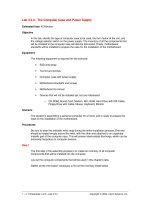Tài liệu The Blackwell Encyclopedic Dictionary of Finance pptx
Bạn đang xem bản rút gọn của tài liệu. Xem và tải ngay bản đầy đủ của tài liệu tại đây (1.79 MB, 389 trang )
2
THE BLACKWELL ENCYCLOPEDIA OF MANAGEMENT
EDITED BY CARY L. COOPER AND CHRIS ARGYRIS
Blackwell Encyclopedic Dictionary of Accounting
Edited by A. Rashad Abdel-khalik
Blackwell Encyclopedic Dictionary of Strategic Management
Edited by Derek F. Channon
Blackwell Encyclopedic Dictionary of Management Information Systems
Edited by Gordon B. Davis
Blackwell Encyclopedic Dictionary of Marketing
Edited by Barbara R. Lewis and Dale Littler
Blackwell Encyclopedic Dictionary of Managerial Economics
Edited by Robert McAuliffe
Blackwell Encyclopedic Dictionary of Organizational Behavior
Edited by Nigel Nicholson
Blackwell Encyclopedic Dictionary of International Management
Edited by John J. O'Connell
Blackwell Encyclopedic Dictionary of Finance
Edited by Dean Paxson and Douglas Wood
Blackwell Encyclopedic Dictionary of Human Resource Management
Edited by Lawrence H. Peters, Charles R. Greer, and Stuart A. Youngblood
Blackwell Encyclopedic Dictionary of Operations Management
Edited by Nigel Slack
Blackwell Encyclopedic Dictionary of Business Ethics
Edited by Patricia H. Werhane, and R. Edward Freeman
3
The Blackwell Encyclopedic Dictionary of Finance
Edited by Dean Paxson and Douglas Wood
Manchester Business School
4
Disclaimer:
Some images in the original version of this book are not available for inclusion in the
netLibrary eBook.
Copyright © Blackwell Publishers Ltd, 1997, 1998
Editorial Organization © Dean Paxson and Douglas Wood, 1997, 1998
First published 1997
First published in paperback 1998
2 4 6 8 10 9 7 5 3 1
Blackwell Publishers Inc.
350 Main Street
Malden, Massachusetts 02148
USA
Blackwell Publishers Ltd
108 Cowley Road
Oxford OX4 1JF
UK
All rights reserved. Except for the quotation of short passages for the purposes of criticism
and review, no part of this publication may be reproduced, stored in a retrieval system, or
transmitted, in any form or by any means, electronic, mechanical, photocopying, recording or
otherwise, without the prior permission of the publisher.
Except in the United States of America, this book is sold subject to the condition that it shall
not, by way of trade or otherwise, be lent, resold, hired out, or otherwise circulated without
the publisher's prior consent in any form of binding or cover other than that in which it is
published and without a similar condition including this condition being imposed on the
subsequent purchaser.
Library of Congress Cataloging-in-Publication Data
The Blackwell encyclopedic dictionary of finance / edited by Dean
Paxson and Douglas Wood.
p. cm
Originally published as a volume in The Blackwell encyclopedia of management, 1997
Includes bibliographical references and index.
ISBN 1–55786–912–X (alk. paper)
ISBN 0–631–21188–8 (pbk. : alk. paper)
1. Finance– – Dictionaries. I. Paxson, Dean. II. Wood, Douglas.
5
HG151.B49 1998 98–26082
332'.03—dc21 CIP
British Library Cataloguing in Publication Data
A CIP catalogue record for this book is available from the British Library.
Typeset in 9 1/2 on 11pt Ehrhardt by Page Brothers, Norwich
Printed in Great Britain by T. J. International Ltd, Padstow, Cornwall
This book is printed on acid-free paper
6
CONTENTS
Preface 9
A 18
Agency Theory 18
Artificial Neural Networks 21
Asset Allocation 24
Asset Pricing 26
B 34
Bankruptcy 34
Banks as Barrier Options 38
Bid–Ask Spread 41
Black–Scholes 43
C 45
Capital Adequacy 45
Capital Structure 51
Catastrophe Futures and Options 55
Commodity Futures Volatility 57
Conditional Performance Evaluation 60
Consolidation 64
Contagion 68
Contingent Claims 70
Convenience Yields 72
Convertibles 78
Corporate Governance 81
Corporate Takeover Language 85
Cost of Capital 88
D 91
Debt Swaps 91
Deposit Insurance 95
Discounted Cash Flow Models 100
Disinvestment Decisions 103
Dividend Growth Model 106
Dividend Policy 109
E 113
Electronic Banking 113
Electronic Payments Systems 120
Embedded Inflation 124
Ethics in Finance 127
Eurocredit Markets 133
Event Studies 137
Exotic Options 141
Expectations 146
7
Experimental Asset Markets 149
F 152
Fat Tails in Finance 152
Financial Distress 161
Foreign Exchange Management 165
Foreign Exchange Markets 168
Futures and Forwards 176
Fuzzy Logic 178
G 180
Game Theory in Finance 180
Growth by Acquisition 187
H 191
Hedging 191
I 194
Initial Public Offerings (IPOS) 194
Insider Trading Law (US) 198
Insurance 200
Insurance Derivatives 206
International Initial Public Offerings 212
Investment Banking 216
Iowa Electronic Market 219
L 223
Leasing 223
Log Exponential Option Models 226
M 229
Market Efficiency 229
Mergers and Acquisitions 234
Mutual Funds 245
N 247
Noise Trader 247
Note Issuance Facilities 251
P 254
Persistence of Performance 254
Portfolio Management 259
Portfolio Performance Measurement 266
Price/Earnings Ratio 275
Privatization Options 277
Program Trading 282
Project Financing 284
R 287
Real Options 287
Regulation of US Equity Markets 294
Restructuring and Turnaround 297
Retail Banking 301
8
Risk Analysis 306
Rollover Risk 308
S 311
Scrip Dividend 311
Securitization 313
Share Repurchases 317
Short-Termism 319
Sovereign Risk 325
Speculation 328
Stability of Returns 331
State-Contingent Bank Regulation 334
Stochastic Processes 337
Stock Market Indices 340
Syndicated Euroloans 343
T 346
Tactical Asset Allocation 346
Term Structure Models 348
Time Series Analysis 357
Transaction Costs 359
Transition Economies 361
V 366
Valuing Flexibility 366
Venture Capital 370
Volatility 376
Volatility Risk Pricing 381
Volatility Smile 384
W 387
Warrants 387
9
Preface
Although the basic purposes of finance, and the nature of the core instruments used in
attaining them, are relatively constant, recent years have seen an explosion in complexity of
both products and techniques.
A number of forces are driving this explosion. The first is internationalization encompassing
a dramatic growth in the number of countries with stock markets, convertible currencies and
a positive regime for foreign investors. For a number of years the more adventurous
institutional and private investors have been increasing the proportion of their investments in
foreign markets in general and emerging markets in particular in search of growth, higher
returns and better diversification. Reflecting this, finance has begun the long process of
overhauling the traditionally domestic measurement of risk and return. In the new world
order in which the next generation is likely to see an unprecedented transfer of economic
power and influence from slow growing developed economies to the high growth tigers in
Asia and the Pacific Rim, the ability of financial markets to recognize and accommodate the
changes will be a priority.
The second change has come from dramatic falls in the costs of both information and
transaction processing. More information is available and it is available more quickly in more
places. Improved databases allow sophisticated analysis that would have been impossible a
few years ago and data intensive artificial intelligence techniques allow a much richer array
of market structures to be considered. The switch to electronic systems of transactions and
trading has dramatically lowered costs, allowing increased arbitrage and stimulating the
widespread use of complex new derivative products and products offering potentially an
infinity of combinations of underlying products. It is no exaggeration to claim that these new
techniques and instruments can be used to provide a proxy for any underlying traded
instrument.
This power is increasingly used in the marketplace to provide the financial community with
new choices, including performance guarantees and indexed products. The development of
traded instruments provides an ability to pinpoint exposures precisely and this has lead to a
new science of risk management, where the net exposures of a portfolio of risky assets such
as securities or bank loans can be estimated and, where required, selectively or completely
hedged by buying opposite exposures in the marketplace. Not surprisingly, this encyclopedic
dictionary reflects these new techniques which are inexorably creating a world in which
financial assets are priced in a seamless global marketplace.
New technology has helped in selecting entries for the dictionary. A word count of titles in
finance and business journals was used to identify the frequency with which particular terms
appeared and this was used as a primary guide to the priority and length of entries. To
accommodate new topics such as real options that are only just emerging into the literature,
we also included some entries where interest was growing rapidly towards the end of the
search period.
10
In compiling the dictionary we have been privileged in the support we have received from a
wide range of distinguished contributors who have taken the time from a busy programme of
research and publication to summarize the often voluminous literature in their specialist areas
into an accessible form. Inevitably the technical content of some of the entries reflects the
rocket science development
in the areas covered, but all entries provide an initial definition and bibliographic references
for the less expert.
Finally, we would like to thank Joanne Simpson and Catherine Dowie for their support for
this project. The demands of monitoring and recording the progress of contributions as they
passed from commissioning through each stage of the editing process to final completion
provided an essential foundation to the project.
DEAN PAXSON
DOUGLAS WOOD
11
Contributors
Reena Aggarwal
Georgetown University
Lakshman A. Alles
Curtin University of Technology, Perth
Paul Barnes
University of Nottingham
Giovanni Barone-Adesi
University of Alberta
Joyce E. Berg
University of Iowa
Ramaprasad Bhar
University of Technology, Sydney
David Blake
Birkbeck College, University of London
John Board
London School of Economics
David Brookfield
University of Liverpool
Frank Byrne
Manchester Business School
Peter Byrne
University of Reading
Nusret Cakici
City College, The City University of New York
David Camino
Universidad Carlos III de Madrid
12
Philip Chang
University of Calgary
Derek Channon
Imperial College, London
Nick Collett
Manchester Business Shool
Oscar Couwenberg
University of Gröningen
Susan J. Crain
University of Oklahoma
Peter J. DaDalt
Georgia State University
Ian Davidson
Warwick University
Suresh Deman
University of Bradford and Mayo-Deman Consultants
Istemi S. Demirag
University of Sheffield
Steven A. Dennis
University of New South Wales
Athanasios Episcopos
Clarkson University
Vihang R. Errunza
McGill University
Ismail Ertürk
Manchester Business School
Heber Farnsworth
University of Washington
Robert Forsythe
University of Iowa
13
Gerald T. Garvey
Sydney University
Gordon Gemmill
City University Business School
Debra A. Glassman
University of Washington
Leslie M. Goldschlager
Monash University
Ian R. Harper
Melbourne Business School
Christian Haefke
Institute for Advanced Studies, Vienna
Christian Helmstein
Institute for Advanced Studies, Vienna
Ivailo Izvorski
University of Yale
Nikunj Kapadia
New York University
Jongchai Kim
Georgia State University
Paul Kofman
Monash University
M. Ameziane Lasfer
City University Business School
Mark Laycock
Bank of England
Ricardo Leal
University of Nevada, Reno
14
Jae Ha Lee
University of Oklahoma
Milan Lehocky
Manchester Business School
Joakim Levin
Stockholm School of Economics
Ginette V. McManus
St Joseph's University
Steven V. Mann
University of South Carolina
Sumon C. Mazumdar
McGill University
Arie L. Melnik
University of Haifa
S. Nagarajan
McGill University
Anthony Neuberger
London Business School
Gregory R. Niehaus
University of South Carolina
David P. Newton
Manchester Business School
Jeffry Netter
University of Georgia
Katherine O'Sullivan
Manchester Business School
Joseph Ogden
State University of New York at Buffalo
Per Olsson
Stockholm School of Economics
15
James E. Owers
Georgia State University
Francesco M. Paris
Università di Brescia
Dean A. Paxson
Manchester Business School
Jose Pereira
Manchester Business School
Steven Peterson
Virginia Commonwealth University
Steven E. Plaut
University of Haifa
Sunil Poshakwale
Manchester Business School
David M. Power
University of Dundee
Vesa Puttonen
Helsinki School of Economics and Business Administration
Thomas A. Rietz
University of Iowa
Michelle A. Romero
Georgia Institute of Technology
Klaus Sandmann
University of Bonn
Sudipto Sarkar
National University of Singapore
Charles Schell
Manchester Business School
16
C. W. Sealey
McGill University
Paul Seguin
University of Michigan
Richard W. Sias
Washington State University
Thomas F. Siems
Federal Reserve Bank of Dallas
Joseph F. Sinkey, Jr.
University of Georgia
Charles Sutcliffe
Southampton University
Amadou N. R. Sy
McGill University
Stephen J. Taylor
Lancaster University
David C. Thurston
Henderson State University
Alireza Tourani Rad
University of Limburg, Maastricht
Alexander Triantis
University of Maryland
Nikhil P. Varaiya
San Diego State University
Chris Veld
Tilburg University
Anne Fremault Vila
London School of Economics
Premal Vora
King's College
17
Ed Vos
University of Waikato
Charles W. R. Ward
University of Reading
Nick Webber
Warwick University
Ivo Welch
Anderson Graduate School of Management, UCLA
Jonathon Williams
University of Wales
Douglas Wood
Manchester Business School
Robert Wynn
University of Liverpool
Oren V. Zimmerman
Mississippi State University
18
A
Agency Theory
When human interaction is viewed through the lens of the economist, it is presupposed that
all individuals act in accordance with their self-interest. Moreover, individuals are assumed to
be cognizant of the self-interest motivations of others and can form unbiased expectations
about how these motivations will guide their behavior. Conflicts of interest naturally arise.
These conflicts are apparent when two individuals form an agency relationship, i.e. one
individual (principal) engages another individual (agent) to perform some service on his/her
behalf. A fundamental feature of this contract is the delegation of some decision-making
authority to the agent. Agency theory is an economic framework employed to analyze these
contracting relationships. Jensen and Meckling (1976) present the first unified treatment of
agency theory.
Unless incentives are provided to do otherwise or unless they are constrained in some other
manner, agents will take actions that are in their self-interest. These actions are not
necessarily consistent with the principal's interests. Accordingly, a principal will expend
resources in two ways to limit the agent's diverging behavior: (1) structure the contract so as
to give the agent appropriate incentives to take actions that are consistent with the principal's
interests and (2) monitor the agent's behavior over the contract's life. Conversely, agents may
also find it optimal to expend resources to guarantee they will not take actions detrimental to
the principal's interests (i.e. bonding costs). These expenditures by principal and/or agent may
be pecuniary/non-pecuniary and are the costs of the agency relationship.
Given costly contracting, it is infeasible to structure a contract so that the interests of both the
principal and agent are perfectly aligned. Both parties incur monitoring costs and bonding
costs up to the point where the marginal benefits equal the marginal costs. Even so, there will
be some divergence between the agent's actions and the principal's interests. The reduction in
the principal's welfare arising from this divergence is an additional cost of an agency
relationship (i.e. ''residual loss"). Therefore, Jensen and Meckling (1976) define agency costs
as the sum of: (1) the principal's monitoring expenditures; (2) the agent's bonding
expenditures; and (3) the residual loss.
Barnea et al. (1985) divide agency theory into two parts according to the type of contractual
relationship examined – the economic theory of agency and the financial theory of agency.
The economic theory of agency examines the relationship between a single principal who
provides capital and an agent (manager) whose efforts are required to produce some good or
service. The principal receives a claim on the firm's end-of-period value. Agents are
compensated for their efforts by a dollar wage, a claim on the end-of-period firm value, or
some combination of the two.
19
Two significant agency problems arise from this relationship. First, agents will not put
forward their best efforts unless provided the proper incentives to do so (i.e. the incentive
problem). Second, both the principal and agent share in the end-of-period firm value and
since this value is unknown at the time the contract is negotiated, there is a risk sharing
between the two parties (i.e. the risk-sharing problem). For example, a contract that provides
a constant dollar compensation for the agent (principal) implies that all the risk is borne by
the principal (agent).
Contracts that simultaneously solve the incentive problem and the risk-sharing problem are
referred to as "first-best." First-best contracts provide agents with incentives to expend an
optimal amount of effort while producing an optimal distribution of risk between principal
and agent. A vast literature examines these issues (see e.g. Ross, 1973; Shavell, 1979;
Holmstrom, 1979).
The financial theory of agency examines contractual relationships that arise in financial
markets. Three classic agency problems are examined in the finance literature: (1) partial
ownership of the firm by an owner-manager; (2) debt financing with limited liability; and (3)
information asymmetry. A corporation is considered to be a nexus for a set of contracting
relationships (Jensen and Meckling, 1976). Not surprisingly, conflicts arise among the
various contracting parties (manager, shareholder, bondholders, etc.).
When the firm manager does not own 100 percent of the equity, conflicts may develop
between managers and shareholders. Managers make decisions that maximize their own
utility. Consequently, a partial owner-manager's decisions may differ from those of a
manager who owns 100 percent of the equity. For example, Jensen (1986) argues that there
are agency costs associated with free cash flow. Free cash flow is discretionary cash available
to managers in excess of funds required to invest in all positive net present value projects. If
there are funds remaining after investing in all positive net present value projects, managers
have incentives to misuse free cash flow by investing in projects that will increase their own
utility at the expense of shareholders (see Mann and Sicherman, 1991).
Conflicts also arise between stockholders and bondholders when debt financing is combined
with limited liability. For example, using an analogy between a call option and equity in a
levered firm (Black and Scholes, 1973; Galai and Masulis, 1976), one can argue that
increasing the variance of the return on the firm's assets will increase equity value (due to the
call option feature) and reduce debt value (by increasing the default probability). Simply put,
high variance capital investment projects increase shareholder wealth through expropriation
from the bondholders. Obviously, bondholders are cognizant of these incentives and place
restrictions on shareholder behavior (e.g. debt covenants).
The asymmetric information problem manifests itself when a firm's management seeks to
finance an investment project by selling securities (Myers and Majluf, 1984). Managers may
possess some private information about the firm's investment project that cannot be credibly
conveyed (without cost) to the market due to a moral hazard problem. A firm's securities will
20
command a lower price than if all participants possessed the same information. The
information asymmetry can be resolved in principle with various signaling mechanisms. Ross
(1977) demonstrates how a manager compensated by a known incentive schedule can use the
firm's financial structure to convey private information to the market.
Bibliography
Barnea, A., Haugen, R. & Senbet, L. (1985). Agency problems and financial contracting.
Englewood Cliffs, NJ: Prentice Hall.
Black, F. & Scholes, M. (1973). The pricing of options and corporate liabilities. Journal of
Political Economy, 81, 637–54.
Galai, D. & Masulis, R. (1976). The option pricing model and the risk factor of stock.
Journal of Financial Economics, 3, 53–82.
Holmstrom, B. (1979). Moral hazard and observability. Bell Journal of Economics, 10,
74–91.
Jensen, M. (1986). Agency costs of free cash flow. American Economic Review, 76, 323–29.
Jensen, M. & Meckling, W. (1976). Theory of the firm: managerial behavior, agency costs,
and ownership structure. Journal of Financial Economics, 3, 306–60.
Mann, S. & Sicherman, N. (1991). The agency costs of free cash flow: acquisition activity
and equity issues. Journal of Business, 64, 213–27.
Myers, S. & Majluf, M. (1984). Corporate financing and investment decisions when firms
have information that investors do not have. Journal of Financial Economics, 13, 187–221.
Ross, S. (1973). The economic theory of agency: the principal's problem. American
Economic Review, 62, 134–39.
Ross, S. (1977). The determination of financial structure: the incentive signalling approach.
Bell Journal of Economics, 8, 23–40.
Shavell, S. (1979). Risk-sharing and incentives in the principal–agent relationship. Bell
Journal of Economics, 10, 55–73.
STEVEN V. MANN
21
Artificial Neural Networks
Artificial neural networks (ANNs) are learning algorithms in the form of computer programs
or hardware. ANNs are characterized by an architecture and a method of training. Network
architecture refers to the way processing elements are connected and the direction of the
signals exchanged. A processing element or unit is a node where input signals converge and
are transformed to outputs via transfer or activation functions. The values of outputs are
usually multiplied by weights before they reach another node. The purpose of training is to
find optimal values of these weights according to a criterion. In supervised training, inputs
are presented to the network and outputs are compared to the desired or target outputs.
Weights are then adjusted to minimize an objective function such as the root mean square
error for instance. In unsupervised training, the network itself finds its own optimal
parameters.
Although there are several types of neural networks, a simple example of ANN is the
multilayer perceptron. The middle sets of units are called hidden layers and the other two
input and output layers. The transfer functions in the input and output layers can be identities,
and those of the hidden layer are usually sigmoid or hyperbolic tangent functions. These
functions map the sum of weighted inputs to the range between zero and one or between
minus one and plus one. The flow of signals in the example is unidirectional giving the name
feedforward to the whole network. One can have also the output from the network and
connect it to the inputs thus leading to recurrent networks which are useful for time series
modeling. Typically, the hidden layers contain several processing elements. Obviously the
outputs are modeled as highly non-linear functions of the original inputs. Thus, it is the
architecture of units that allow an ANN to be a universal approximator. In other words an
ANN can recover an unknown mapping from the input to the output space as long as it
contains enough processing elements (White et al., 1992). The network can be trained with
backpropagation (Rumelhart and McClelland, 1986), which seeks a minimum in the error
function via the gradient descent method. Weights are adjusted in the direction that reduces
the value of the error function after each presentation of the input records.
ANNs sometimes share the problem of local minima and the problem of overtraining.
Because of the non-linearity involved, the algorithm may not always reach a global minimum.
Overtraining refers to the situation where the network literally memorizes the inputs and
cannot generalize (predict well) when it is applied to a new set of data. However, there are
ways to overcome these problems and ANNs are very useful. In fact on many occasions they
are superior to linear models in terms of prediction accuracy. A correctly trained network
should be able to generalize, that is, to recognize patterns in data it has not yet seen. Although
statistical measures such as t-ratios are not available, one can perform sensitivity analysis.
This consists of varying one input within a reasonable range and observing how the estimated
output function behaves.
22
Neural networks have been successfully applied in finance and economics, although research
in this area is still new. Examples include forecasting security prices, rating bonds, predicting
failure of banks or corporate mergers, and conducting portfolio management (Refenes, 1995).
Although statistical models and ANNs overlap considerably, the two sets of models are not
identical. White (1989) and Kuan and White (1992) discuss the parallels between statistical
or econometric models and feedforward networks. Cheng and Titterington (1994) study
ANNs from a statistical perspective, and Ripley (1994) compares standard classification
techniques with ANNs. Classification is an area in which neural networks have been useful
because they are often capable of sharply discriminating between classes of inputs with
different characteristics. The general literature on ANNs is extensive. Hecht-Nielsen (1990)
and Wasserman (1993) are two introductory books. The Internet news group
comp.ai.neural_nets is an informative forum for exploring this growing field.
Bibliography
Cheng, B. & Titterington, D. (1994). Neural networks: a review from a statistical perspective.
Statistical Science, 9, 2–54.
Hecht-Nielsen, R. (1990). Neurocomputing. Reading, MA: Addison-Wesley.
Kuan, C. & White, H. (1992). Artificial neural networks: an econometric perspective.
Econometric Reviews, 13, 1–91.
Refenes, A. (1995) (Ed.) Neural networks in the capital markets. New York: John Wiley.
Ripley, B. (1994). Neural networks and related methods for classification. Journal of the
Royal Statistical Society, 56, 409–56.
Rumelhart, E. & McClelland, J. (1986). Parallel distributed processing: Explorations in the
microstructure of cognition. Cambridge, MA: MIT Press.
Wasserman, P. (1993). Advanced methods in neural computing. New York: Van Nostrand
Reinhold.
White, A., Gallant, A. R., Hornik, K., Stinchcombe, M. & Wooldridge, J. (1992). Artificial
neural networks: Approximation and learning theory. Cambridge, MA.: Blackwell.
White, H. (1989). Learning in artificial neural networks: a statistical perspective. Neural
Computation 1, 425–64.
ATHANASIOS EPISCOPOS
23
24
Asset Allocation
In the analysis of portfolio management, the initial work of Markowitz (1959) was directed
towards finding the optimal weights in a portfolio. It was quickly realized that the decisions
involved in building up a portfolio were less frequent than the decisions to modify existing
portfolios. This is especially important when analyzing how profitable portfolio managers
have been over time. If, for example, a portfolio consists of equities and bonds, some
investment managers might be particularly skilled in choosing specific companies in which
the portfolio should invest, while others might be able to forecast at which times the portfolio
should be more heavily invested in shares. The first type of skill would be classified as being
more concerned with portfolio selection while the latter would be described as connected
with timing or asset allocation.
Asset allocation decisions can be further divided. Investors can decide on an ad hoc basis to
alter their portfolio by changing the weights of the constituent assets as a result of some
specific model. For example, forecasting models are used to predict the performance of
equities relative to bonds or real estate relative to equities. Dependent on the outcome of
these forecasts, the investor will switch into or out of the asset being forecasted. Models are
used to derive frequent forecasts of one asset against another and to move the portfolio day
by day depending on the outcome of the forecasting model. This type of model is sometimes
referred to as tactical asset allocation (TAA) and in practice is used in conjunction with some
sophisticated trading in derivatives such as options or futures. Instead of buying more shares,
this system buys options or futures in an index representing equities. If equities rise in value,
so will the options and futures position and the portfolio thereby will increase in value to a
greater extent than underlying equities. TAA is used to adjust portfolio exposure to various
factors such as interest rates and currency movements as well as overseas investments (see
Arnott et al., 1989).
An alternative category of asset allocation is the technique of dynamic asset allocation, where
there is less emphasis on forecasting which component assets will perform well in the next
period and more on setting up a policy by which the portfolio reacts automatically to market
movements. This can be organized with the help of options and futures but can also be
carried out by adjusting the weights of the component assets in the light of predetermined
rules. For example, the policy of buying an asset when that asset has performed well in the
current period and selling when it has done badly can be carried out in such a way as to
provide portfolio insurance, i.e. it protects the portfolio by reducing the exposure to
successive falls in the value of one of its constituent assets. An alternative dynamic asset
allocation policy is that carried out by rebalancing so as to maintain a reasonably constant
proportion in each asset. This involves selling those assets which have just risen in value and
selling those assets which have just fallen in value. The two strategies are profitable in
different phases of the market. When the market is moving strongly, the insurance policy is
most successful. If, however, the market is tending to oscillate without a strong trend, the
25
rebalancing policy works best. These principles are well illustrated in Perold and Sharpe
(1988).
Bibliography
Arnott, R. D., Kelso, C. M., Kiscadden, S. & Macedo, R. (1989). Forecasting factor returns:
an intriguing possibility. Journal of Portfolio Management, 16, 28–35.
Markowitz, H. (1959). Portfolio selection: Efficient diversification of investments. New York:
John Wiley and Sons.
Perold, A. & Sharpe, W. F. (1988). Dynamic strategies for asset allocation. Financial
Analysts Journal, 44, 16–27.
Sharpe, W. F. (1992). Asset allocation: management style and performance measurement.
Journal of Portfolio Management, 18, 7–19.
C. W. R. WARD









